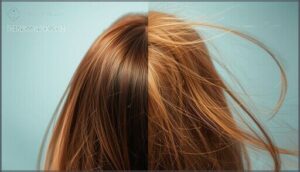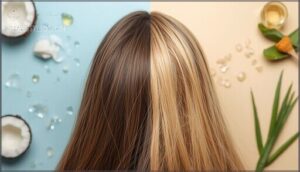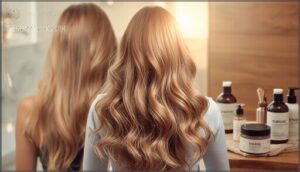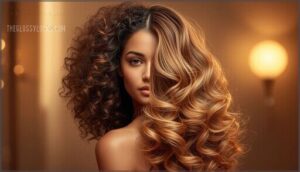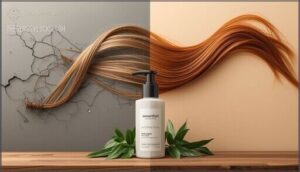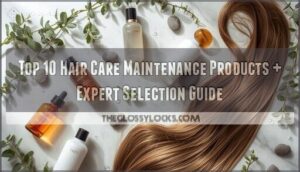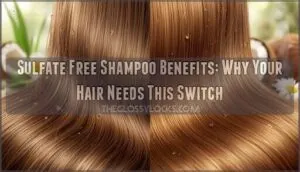This site is supported by our readers. We may earn a commission, at no cost to you, if you purchase through links.
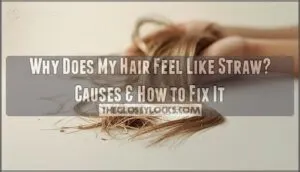
When protein bonds break down and protective cuticle layers erode, your once-healthy strands lose their flexibility and moisture-holding capacity. The culprits range from heat tools cranked above 300°F to chemical treatments that strip away natural defenses.
Understanding exactly what’s destroying your hair gives you the power to reverse the damage. Your strands don’t have to stay brittle—targeted strategies can rebuild strength and restore softness.
Table Of Contents
- Key Takeaways
- Hair Feels Like Straw
- Why Hair Feels Like Straw
- Causes of Dry Hair
- Preventing Straw Like Hair
- Restoring Hair Health
- Frequently Asked Questions (FAQs)
- How to fix hair that feels like straw?
- How do you hydrate your hair?
- How to fix dry brittle hair?
- Why does my hair feel like straw as I get older?
- Can hormonal changes affect hair texture?
- Does hard water impact hair condition?
- Are there genetic factors in hair dryness?
- Can stress lead to straw-like hair?
- Does hair porosity influence straw-like texture?
- Can stress or hormonal changes affect hair texture?
- Conclusion
Key Takeaways
- Straw-like hair signals structural collapse where chemical treatments increase cuticle permeability by up to 250% and heat styling above 212°F breaks down internal proteins, reducing moisture retention by 42%—this isn’t surface dryness but deep damage to your hair’s protein bonds and moisture-holding capacity.
- The main culprits destroying hair texture are chemical processing (bleaching can drop tensile strength by 40% after three cycles), heat styling above 300°F (which converts flexible α-keratin into brittle β-keratin), environmental factors like UV radiation (reducing strength by 30%), and harsh habits like overwashing that strips 70% of natural oils.
- Prevention requires keeping heat tools below 365°F, switching to sulfate-free shampoos that retain 35-40% more natural oils, getting trims every 6-8 weeks to reduce breakage by 30%, and using protective styling that increases moisture retention by up to 40%.
- Restoration demands weekly deep conditioning treatments (reducing breakage by 55%), leave-in bonding treatments that rebuild disulfide bonds (delivering up to 85% damage reversal), and nourishing hair masks with keratin and natural oils that boost hydration up to 6.5 times compared to untreated hair.
Hair Feels Like Straw
When your hair feels like straw, it’s not just one thing going wrong—it’s usually a combination of damage sources working against you. Understanding what’s breaking down your hair’s natural structure helps you target the real culprits instead of guessing.
Here are the four main reasons your hair has lost its softness and strength.
Chemical Processing Effects
The fallout from chemical processing runs deeper than most people realize. When you color, bleach, or relax your hair, you’re fundamentally dismantling the protein bonds that give your strands strength and flexibility.
Research shows that nearly 49% of people who undergo chemical treatments choose hair coloring, while 40% opt for straightening—and about 90% of women dealing with hair breakage have used these services. The chemicals strip away your hair’s protective cuticle layer, leaving the cortex exposed and vulnerable.
What’s worse? Each treatment compounds the damage, especially if you’re overlapping procedures before your hair fully recovers. That’s why trichologists recommend waiting 6–8 weeks between sessions—your hair needs time to rebuild what chemical processing destroys. Understanding the effects of chemical hair damage is vital to preventing long-term harm.
Heat Styling Damage
Your heat styling tools aren’t just styling your hair—they’re systematically destroying it. Research shows that flat irons operating at 428°F caused 37.5% of curly hair samples to permanently lose their natural pattern and showed a 75% rate of visible structural damage. That’s because temperatures above 300°F convert your hair’s α-keratin into β-keratin, weakening the fiber and stripping away elasticity.
Heat styling tools above 300°F systematically destroy hair by converting α-keratin to β-keratin, causing permanent structural damage and pattern loss
Blow-drying and straightening increased the odds of microscopic shaft damage by 22 times compared to those who skipped heat tools entirely.
The fix? Lower your tool temperature, use a heat protectant religiously, and embrace air-drying whenever possible—your hair can’t rebuild what thermal damage tears down. Understanding the impact of heat styling tools is vital to preventing further damage.
Environmental Factors
Your hair isn’t just battling your styling tools—environmental damage wages war daily. UV radiation fractures protein bonds, reducing tensile strength by 30% after prolonged sun exposure. Air pollution deposits microscopic particles that trigger oxidative stress, while hard water leaves calcium and magnesium buildup that blocks moisture absorption.
Consider these environmental assaults:
- UV rays: Break down keratin and fade color within 254–400 nm wavelengths
- Water quality: Hard water increases breakage by 17% through mineral deposits
- Humidity effects: Low humidity (<40%) causes dehydration; high levels weaken disulfide bonds
- Climate change: Weather extremes accelerate cuticle damage and moisture loss
Environmental factors don’t take breaks—protection matters year-round.
Harsh Haircare Habits
Beyond environmental damage, your own haircare routine might be sabotaging your strands. Overwashing with harsh shampoos strips up to 70% of natural oils, while rough combing when wet increases breakage by 50%. Heat styling without protection accelerates moisture loss, and chemical overload from frequent processing weakens hair’s structure. Even well-intentioned habits—like aggressive towel-drying or tight ponytails—create friction and traction that turn healthy hair brittle.
Daily mistakes compounding damage:
- Overwashing removes protective sebum, leaving hair vulnerable to dryness
- Rough combing tears through wet strands when they’re most fragile
- Excessive styling with uncovered elastics causes focal breakage points
- Chemical overload from back-to-back treatments compromises protein bonds
Why Hair Feels Like Straw
What triggers that unmistakable coarse, brittle texture? Your hair feels like straw because its structural integrity has collapsed—proteins have degraded, moisture has escaped, and the hair cuticle is damaged beyond normal dryness.
Chemical processing increases cuticle permeability by up to 250%, preventing strands from holding hydration. Heat styling above 212°F breaks down internal proteins, reducing moisture retention by 42%. Environmental factors like UV exposure decrease hydration by 21%, while sulfate shampoos strip 52% of natural lipid content.
This isn’t surface-level dryness—it’s deep hair damage affecting your moisture balance and protein structure. Straw hair signals that your hair bond repair mechanisms are overwhelmed. Understanding these causes helps you move from guessing to targeting what’s breaking down your strands’ natural flexibility and shine.
Treating straw hair starts with identifying the hardest-hitting damage source, then applying focused dryness prevention strategies.
Causes of Dry Hair
Understanding what’s making your hair dry is the first step to fixing it. Several factors can strip moisture and leave your strands feeling damaged.
Let’s break down the main culprits behind that straw-like texture.
Lack of Moisture
Your hair’s moisture balance is everything—without it, you’re left with brittle, lifeless strands. Human hair naturally holds 10–15% water content, but chemical treatments can slash that by up to 50%, turning your once-vibrant locks into straw. When hair moisture drops too low, you lose elasticity and softness.
Dryness causes stem from overwashing, which strips protective oils, and heat styling that accelerates water evaporation from each strand.
Your hair’s porosity also plays a role: high porosity struggles with moisture retention, while low porosity resists hydration altogether. The result? Hair that craves moisture but can’t hold onto it.
Haircuticle Damage
Chemical damage, heat styling, and physical grooming stress can strip away your hair cuticle—the protective armor surrounding each strand. Healthy hair usually has 6–8 overlapping cuticle layers, but repeated chemical treatments disrupt the bonds between these scales, causing them to lift, crack, or vanish entirely. When cuticle damage exposes the cortex beneath, your hair loses its ability to retain moisture and becomes vulnerable to breakage. This cuticle repair crisis explains why straw hair feels rough and tangles easily—you’re basically touching exposed, damaged keratin without its protective shield.
Your hair cuticle damage shows up as:
- Increased hair porosity that can’t lock in hair moisture, leading to chronic dryness
- Reduced tensile strength (normally 150–270 MPa) that makes strands snap under routine styling
- Loss of hydrophobic protection as the outermost layer erodes, compromising scalp health
- Visible surface roughness detected under microscopy, revealing weakened follicle care foundation
- Accelerated hair breakage at sites where cuticle cells are missing, exposing vulnerable cortex tissue
Keratin treatment and focused cuticle repair strategies can rebuild this protective barrier, but prevention beats restoration every time.
Overprocessing
Your hair doesn’t break down overnight—it’s a cumulative attack. Every time you bleach, dye, or chemically relax your strands, you’re dismantling the structural integrity that keeps them strong. Overprocessing means piling chemical treatments on top of each other before your hair has recovered, and the protein loss becomes irreversible. After just three bleaching cycles, tensile strength drops up to 40%, while repeated dyeing can slash mechanical strength by 28%. That’s not styling—that’s demolition.
Chemical damage from overprocessing shows up as:
- Over bleaching strips up to 25% of natural lipids after three sessions, leaving hair defenseless
- Protein loss reaches 18% in heavily processed hair, weakening every strand
- Chemical treatments convert keratin bonds to brittle cysteic acid through oxidation
- Hair breakage accelerates when cuticle detachment exceeds 60% after cumulative exposure
- Heat abuse combined with chemicals creates compounding damage that’s nearly impossible to reverse
Poor Diet
What you eat doesn’t just fuel your body—it’s the blueprint for every strand that grows from your scalp. Nutrient deficiencies directly sabotage hair health, turning strong keratin into fragile, straw-like fibers.
When your caloric intake drops too low, hair follicles shut down energy-intensive keratin production, triggering brittle texture and shedding. Protein restrictions disrupt amino acid availability, weakening hair structure by up to 40% in severe cases. Essential fatty acids maintain moisture and shine—without them, your scalp can’t produce adequate sebum, leaving strands parched.
Iron deficiency starves follicles of oxygen, while low zinc impairs tissue repair. Micronutrient balance matters too: excess vitamin A or selenium paradoxically accelerates hair loss.
Dietary habits focusing on whole foods rich in protein, iron, omega-3s, and vitamins directly combat hair thinning, restoring the resilience your strands desperately need.
Preventing Straw Like Hair
Once you understand what’s turning your hair into brittle straw, you can take control and stop the damage before it starts. Prevention isn’t complicated—it’s about protecting your hair from the everyday habits that quietly wreak havoc.
Here’s how you keep your strands soft, strong, and far from that dreaded straw-like texture.
Minimizing Heat Styling
Your flat iron and blow dryer aren’t just styling tools—they’re actively breaking down your hair’s structure with every pass. Daily heat styling exposes strands to cumulative thermal damage, and longer hair faces over 720 heat applications before being cut.
Keep styling tools below 365°F to prevent irreversible damage, and embrace heatless methods like overnight braids. When heat styling is necessary, apply heat protectants to reduce surface temperatures by up to 20°F, and air dry until 90% moisture-free first.
Your hair recovery depends on these gentle styling habits, not just occasional breaks from heat.
Using Gentle Products
Your product choices can make or break your hair’s recovery. Sulfate-free shampoos retain 35-40% more natural oils than standard formulas, protecting your strands from the stripping effects that leave hair feeling like straw. Gentle hair products with organic formulas—think argan oil, shea butter, and botanical extracts—provide the moisturizing support your damaged hair desperately needs.
Don’t settle for harsh chemicals when gentler options deliver real results:
- Sulfate-free benefits include reduced scalp irritation by up to 30% within four weeks
- Natural ingredients in gentle shampoos lower breakage rates by 22% compared to conventional products
- Hair product reviews consistently show 4.5-star ratings for improved dryness and comfort
- Organic formulas maintain 20% higher moisture retention, supporting long-term hair hydration
Your hair care products should nourish, not punish.
Regular Trims
You’re switching to gentle products—now lock in that progress with regular trims every 6–8 weeks. This trim frequency removes split ends before they travel upward, reducing breakage rate by 30% and preventing that straw-like texture from taking hold.
Your hair cuticle stays intact, hair damage decreases, and styling ease improves by 31%. Regular trims don’t stall hair growth—they protect it, cutting hair breakage and boosting length retention by over 70%.
Protective Styling
Beyond trimming away damage, you need protective styling to shield your hair from the elements. Hair braiding and low-manipulation styles increase moisture retention by up to 40%, while reducing breakage rates by 50% when properly installed. Box braids, twists, or buns minimize daily handling—tucking away ends decreases friction-related split ends by 35%.
Pair these styles with regular scalp care and moisturizing routines to maintain hydration. Protective styling isn’t about locking hair away—it’s strategic hair shielding that promotes breakage prevention and gives damaged strands the recovery time they desperately need.
Restoring Hair Health
Once you’ve stopped the damage, it’s time to reverse it. Rebuilding straw-like hair requires targeted treatments that repair broken bonds, restore moisture, and strengthen the cuticle.
The strategies below work together to transform brittle strands into soft, healthy hair.
Deep Conditioning Treatments
Deep conditioning treatments act like intensive repair sessions for straw-like hair—they rebuild what heat and chemicals have destroyed. These concentrated formulas infuse moisture into parched strands while repairing structural damage from the inside out. You’re basically giving your hair a chance to recover its natural strength and elasticity.
Here’s your repair roadmap:
- Apply your deep conditioner or hair masking treatment to damp—not soaking—hair, concentrating on mid-lengths to ends where damage peaks.
- Trap heat with a shower cap to boost absorption; this increases moisture repair by up to 30% in a single session.
- Let the conditioning routines work for 20-30 minutes—absorption plateaus beyond this point, so don’t overdo it.
- Rinse with cool water to seal cuticles and lock in hair hydration gains.
Weekly protein treatment sessions reduce breakage by 55% and restore hair moisture content that heat styling strips away.
Leave-in Hair Bonding
Your hair’s rebellion against straw-like texture starts with leave-in hair bonding treatments. These targeted formulas rebuild broken disulfide bonds using bis-aminopropyl diglycol dimaleate and protein restoration technology.
These molecular repair powerhouses work continuously between washes, restoring hair elasticity by reconnecting the structural bonds that chemical processing and heat styling shattered.
Apply leave-in hair treatments to damp hair strands after every wash, focusing on damaged areas where bond repair matters most.
The result? Hair rejuvenation that delivers up to 85% damage reversal and heat protection reaching 450°F, transforming brittle strands into resilient, moisture-locked hair through consistent hair bonding therapy.
Switching to Sulfate-Free
Regarding hair damage from chemicals and heat, sulfate-free shampoo is your first line of defense. These gentle cleansing formulas preserve natural moisture and restore hair pH balance without stripping protective oils. According to 2024 research, sulfate-free products maintain 27% more lipid content in hair shafts and reduce scalp irritation by 42%.
The importance of hair moisture can’t be overstated—using quality hair products means:
- Your color stays vibrant up to four weeks longer
- Scalp health improves with 31% better hydration retention
- Breakage drops by 23% per wash cycle
Consistent hair care maintenance with sulfate-free benefits transforms straw-like strands into resilient, moisturized hair.
Nourishing Hair Masks
Weekly hair masks deliver the deep conditioning and moisture retention your straw-like strands desperately need. Clinical tests show masks with natural oils like argan and jojoba reduce breakage and boost hydration up to 6.5 times—transforming brittle hair into resilient, glossy strands.
Look for mask ingredients like keratin, shea butter, and wheat protein for maximum hair repair and nourishment. Apply your hair treatment for 5–10 minutes weekly, or overnight for intensive hair mask benefits that restore what heat and chemicals stripped away.
Frequently Asked Questions (FAQs)
How to fix hair that feels like straw?
If you want to stop fixing dry, strawlike hair from feeling rough, switch to gentle shampoos, deep conditioner, and nourishing hair masks.
Moisturize hair with natural oils, trim split ends, and protect moisture balance for lasting repair.
How do you hydrate your hair?
Start with deep conditioning treatments once weekly—this locks in hydration for up to two weeks.
Use leave-in conditioners or hair oils like argan between washes to seal moisture.
Switch to sulfate-free shampoos, limit heat styling, and rinse with cool water to close cuticles.
How to fix dry brittle hair?
Think of dry, brittle hair like damaged fabric—it needs repair from the inside out.
Deep condition weekly with protein treatments and hair oils to restore moisture balance, trim split ends regularly, and switch to sulfate-free products that won’t strip natural oils.
Why does my hair feel like straw as I get older?
As you age, your scalp produces less sebum—especially notable after 50—leaving hair drier and more fragile.
Hormonal shifts during menopause, combined with nutrient deficiencies and environmental stressors, accelerate moisture loss and cuticle damage, creating that signature straw-like texture.
Can hormonal changes affect hair texture?
Hormonal fluctuations—whether from pregnancy, menopause, or thyroid imbalances—can dramatically alter your hair’s texture. Estrogen prolongs growth phases, creating thicker strands during pregnancy, while postpartum drops trigger shedding.
Declining estrogen during menopause leaves hair drier and thinner, and hypothyroidism produces coarse, brittle strands.
Does hard water impact hair condition?
Hard water leaves calcium and magnesium deposits on your hair shaft, creating a barrier that blocks moisture absorption and weakens tensile strength by up to 5%.
This mineral buildup reduces shampoo efficiency, triggers scalp irritation, and makes your strands feel coarse and brittle—especially in regions with hardness levels exceeding 180 mg/L.
Are there genetic factors in hair dryness?
Your genes hold surprising power over hair texture and hair dryness. Keratin gene variations, hair lipid metabolism, and ethnic hair differences all influence moisture retention.
If genetic factors shaped your parents’ dry, brittle strands, you’ve likely inherited similar hair follicle function and porosity. Nutritional deficiencies aside, your DNA scripts much of your hair health and nutrition destiny.
Can stress lead to straw-like hair?
Yes—stress directly damages hair health. When cortisol levels spike, your hair follicles synthesize stress hormones locally, disrupting moisture retention and weakening keratin structure.
This oxidative stress degrades protein bonds, leaving strands dry, brittle, and prone to breakage—exactly that straw-like texture you’re battling.
Does hair porosity influence straw-like texture?
Absolutely—hair porosity directly affects texture. High porosity hair loses moisture rapidly due to cuticle damage from chemical processing or heat styling, creating that brittle, straw-like feel.
Low porosity resists hydration, trapping product buildup that mimics dryness and compromises hair elasticity.
Can stress or hormonal changes affect hair texture?
Think your hair’s staging a Victorian-era rebellion? Hormonal imbalance and stress effects genuinely alter your hair texture. Elevated cortisol levels disrupt your scalp’s oil production, while thyroid issues and menopause symptoms shift hair from soft to brittle—demanding intentional hair care to restore hair health.
Conclusion
Here’s the irony: straw-like hair doesn’t appear overnight, yet most people ignore the warning signs until the damage runs deep. Now you know why my hair feels like straw—broken protein bonds, stripped cuticles, relentless heat, and chemical assaults.
You can’t undo yesterday’s damage, but you control what happens next. Deep conditioning treatments, sulfate-free formulas, and heat protection aren’t luxuries—they’re requirements. Your hair rebuilds slowly, one deliberate choice at a time.

